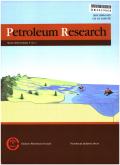比较纳米流体与传统驱替液在毛细管吸胀中的效果
IF 4
Q1 Earth and Planetary Sciences
引用次数: 0
摘要
比较了表面活性剂溶液、聚合物和纳米悬浮液在毛细管吸胀中的效果。采用饱和低粘度(4.2 mPa s)和饱和高粘度(28.9 mPa s)岩心进行了两组毛细管吸胀实验。水、聚丙烯酰胺的聚合物溶液、表面活性剂溶液(AES和SDS)以及球形纳米颗粒悬浮液被认为是替代流体。物质的质量浓度在0.05 ~ 0.25%之间变化。0.1% AES溶液和悬浮液1030的驱替油体积随时间的变化率大于其他驱替液体。聚合物溶液中驱替油体积的增加最小。毛细吸胀作用下的水驱油系数为58%。当使用表面活性剂溶液和悬浮液时,观察到驱油系数的增加:SDS溶液使毛细吸胀率提高了4%,SiO2纳米颗粒悬浮液(10 nm)使毛细吸胀率提高了3%。聚丙烯酰胺溶液使毛细管吸胀率降低了12%。在油品粘度较高的系列中,添加剂的影响更为显著。在0.1% SDS溶液中,毛细吸胀率提高了22%,在0.1% SiO2悬浮液(10 nm)中,毛细吸胀率提高了24%。分析了表面活性剂、聚合物和纳米悬浮液在毛细管吸胀过程中对驱替系数的影响因素。研究表明,纳米悬浮液对驱油系数的积极影响并不亚于表面活性剂溶液,而聚合物溶液对驱油系数的积极影响则远远落后于表面活性剂溶液。本文章由计算机程序翻译,如有差异,请以英文原文为准。
Comparing the effect of nanofluids in capillary imbibition with traditional displacing fluids
The effectiveness of surfactant solutions, polymers and nanosuspensions in capillary imbibition was studied comparatively. Two series of experiments on capillary imbibition with displacing liquids from cores saturated with low-viscosity (4.2 mPa s) and high-viscosity (28.9 mPa s) oil were performed. Water, a polymer solution of polyacrylamide, surfactant solutions (AES and SDS), as well as suspensions of spherical nanoparticles were considered as displacing fluids. The mass concentration of the substances varied from 0.05 to 0.25%. The rate of change in the volume of the displaced oil for 0.1% AES solution and suspension 1030 over time was greater than for other displacing liquids. The smallest increase in the volume of displaced oil was observed for the polymer solution. The coefficient of low-viscosity oil displacement from sandstone by water as a result of capillary imbibition was found to be 58%. When using surfactant solutions and suspensions, an increase in the oil displacement coefficient was observed: the SDS solution increased the capillary imbibition rate by 4%, and the suspension of SiO2 nanoparticles (10 nm) gave a 3% increase. The polyacrylamide solution reduced the capillary imbibition rate by 12%. In the series with higher oil viscosity, the effect of additives was more significant. The rate of capillary imbibition increased by 22% in the case of 0.1% SDS solution and by 24% for 0.1% SiO2 suspension (10 nm). The analysis of the factors influencing the displacement coefficient during capillary imbibition with solutions of surfactants, polymers and nanosuspensions was carried out. It has been shown that nanosuspensions are not inferior to surfactant solutions and leave polymer solutions far behind in terms of their positive effect on the oil displacement coefficient.
求助全文
通过发布文献求助,成功后即可免费获取论文全文。
去求助
来源期刊

Petroleum Research
Earth and Planetary Sciences-Geology
CiteScore
7.10
自引率
0.00%
发文量
90
审稿时长
35 weeks
 求助内容:
求助内容: 应助结果提醒方式:
应助结果提醒方式:


